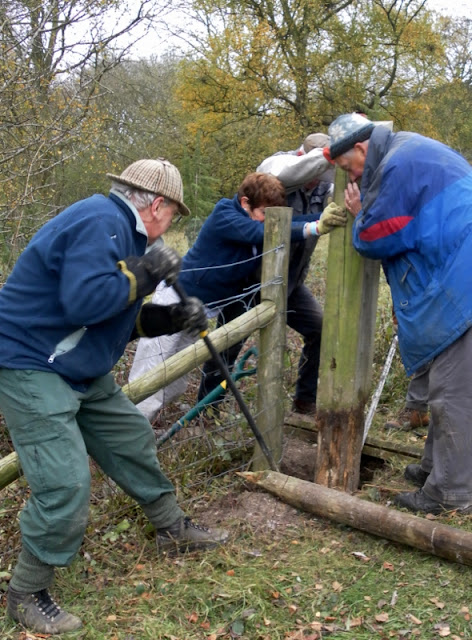By ‘C’:
A round of
applause for the foreman does not happen often at Green Gym. It did today.
This was the
moment of triumph, when a stubborn gate-post, which even more stubborn
Green-Gymmers had applied effort, ingenuity, then more effort into shifting,
finally began to yield:
Session
leader I may have been, but really Graham – dubbed ‘foreman’ for the
day – was the brains and inspiration behind today’s session. He it was who, while I was away, met with the
site manager in advance to recce the job, and organized some extra tools.
As he
explained at the start of the session, really we needed to split into three
teams:
- one group to ‘scrub-bash’, in this case to remove vegetation where it was encroaching on fence-lines in an area where sheep are corralled when they are in transit to fresh pasture
- one group to remove the left gate-post at the end of that area
- and one group to remove the right-hand gate-post
Or: to use
the ‘technical’ terms, “the hanging post and the clanging post”.
Ah, the
things we do for sheep, while all they do is hang out and have a good time.
The trouble
with a gate-post is that it is a bit like an iceberg. It’s big, what you
can see above the ground; but there’s so much more below the surface than you
can easily credit. And, unfortunately,
they rot. So sometimes they have to be
dug out and replaced, and the gate re-hung.
Actually, the first thing to do was to find
the right gate. Not this one …
nor this …
That one, in front of us, was the target:
After detaching the gate itself, step 1 was,
of course, to pull out the old posts, and to remove from them, all the metal
fittings:
Ha!
Step 1 in fact took up the whole session. The right-hand post was rotten, and broke
off. It was then a question of using a pic to
break up the wood left in the hole, and scooping out fragments handful by
handful:
As the hole got deeper, the volunteer on ‘scooping
duty’ (yes, I took my turn) had to get lower and lower:
This was labour- and time-intensive
work. Half-way through the session,
volunteers found themselves re-measuring the original, in the hope that the
task might not be as massive as they anticipated.
Alas, the measuring had been done
correctly. Depth of hole required: 1.3
metres. Depth achieved by then: 0.65
m. And: not having ‘sugar-tongs’ to hand
(even between us, we can’t supply the full range of tools ourselves, and the
site manager was in a meeting today), there naturally came a point where the
hole was simply too deep for the longest human arm to reach.
As for the other gate-post, well that one
would not budge at all. Considerable
ingenuity was applied to try to enable its removal without digging a large hole
all the way round. Here, the team is seeing
whether a trolley jack and a bit of leverage would do the trick. Answer was: no.
Meanwhile, the scrub-bashers were making
excellent progress, on either side of the track, and on either side of the
fence:
By half-time, they had about completed that
particular section:
This led some of the gatepost-removal teams
to suggest that after the break, we should all do a swap round: scrub-bashers
to work on gate-posts; gate-posters to have a breather on the scrub-clearance job
which was almost done.
There are days when the whistle for tea-break
is extra specially welcome. This was one
of them: a little rest for the muscles; the chance to re-think tactics; and, as usual, a
wide-ranging discussion to engage in.
Answers to some of the questions raised:
- There is no such thing as a Tibetan Llama: Tibetan Antelope, Tibetan Argali, Tibetan Gazelle, Tibetan Mastiff, and Tibetan Wild Ass yes, plus wild camels, yaks, wolves, snow leopards, &c; but no llamas spelled with a double ‘l’ in the Himalayas
- The differences between llamas and alpacas: both come from the Andes (Peru and Bolivia), and both are part of the camelid family; but llamas are twice the size (so can be used as pack animals), have more elongated faces and ears, grow coarser hair (which makes for less good fleeces from the human farmer’s PoV), and are more independent-minded
After the break, scrub-bashers ambled on
along further stretches of fence-line, among flora which is certainly very
pretty, but not quite as exotic as that of the Tibetan steppe:
Gate-post extractors conceded that they
needed to excavate a much larger slot around the post which was proving
resistant, and then exert more leverage:
It was a case of trying and trying again –
and trying out one new suggestion after another:
Here, another variation on brute force +
ignorance, trying to ‘wiggle’ the post within the hole:
All credit to Green-Gymmers: they keep
smiling even when things are not going their way:
Eventually, hooray! Patience and determination paid off:
And that was when a spontaneous round of
applause broke out for the foreman. What
a shame he has his back to the camera here, when this ‘big fish’ had, of course,
to be measured:
 |
| “220 altogether!” |
By now we had got to the end of what we could
usefully do in a session. So the new
posts were temporarily lifted into position:
That allowed us to lean the gates against
them, to improvise a barrier across the lane, and so comply with The
Countryside Code (‘leave gates as you find them’):
The rest of the job – sinking the new posts
and hanging the gates – we’re leaving for another group, another time.






























No comments:
Post a Comment